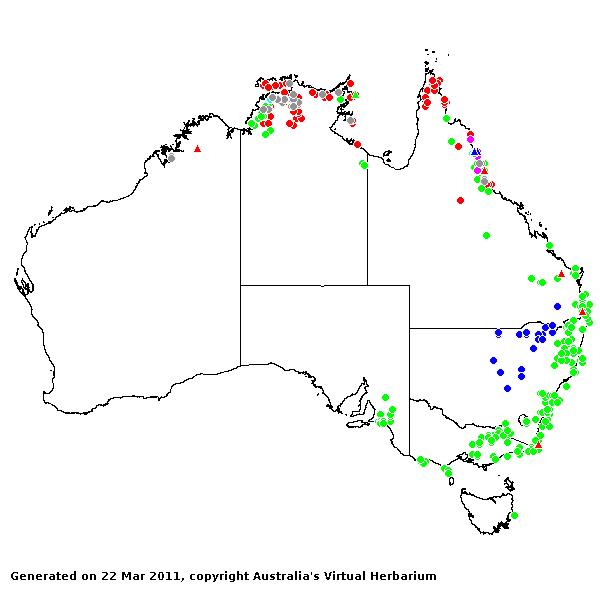Isachne Prodr. 196 (1810).
Derivation:. From Greek iso (equal) and achne (glume), referring to the two equal outer glumes.
Key references (keys and floras):. G.Bentham, Flora Australiensis 7: 624–625 (1878); E.E.Henty, Manual Grasses New Guinea 112–114 (1969); J.W.Vickery, Flora of New South Wales, Gramineae 19: 221–223 (1975); M.Lazarides, Tropical Grasses S.E. Asia 88–92 (1980); J.P.Jessop, Flora of South Australia 4: 1877 (1986); R.D.Webster, Australian Paniceae 101–104 (1987); T.D.Macfarlane, Flora of the Kimberley Region 1179, 1181 (1992); B.K.Simon, Key to Australian Grasses 125–126 (1993); N.G.Walsh, Flora of Victoria 2: 617 (1994); E.Edgar and H.E.Connor, Flora of New Zealand 5: 596–598 (2000); D.Sharp and B.K.Simon, AusGrass (2002); J.P.Jessop, Grasses of South Australia 507 (2006) S.W.L.Jacobs, R.D.B.Whalley & D.J.B.Wheeler, Grasses of New South Wales, 4th ed, 284 (2008).
W.D.Clayton & S.A.Renvoize, Genera Graminum (1986), genus (546).
Native. About 100 species, from tropical and subtropical. 4 species in Australia, WA, NT, SA, Qld, NSW, and Vic. Also New Guinea, Malesia and New Zealand.
Habit. Annual (rarely) or perennial (often aquatic), rhizomatous or stoloniferous or tufted or decumbent. Culms herbaceous (rarely almost shrubby). Leaf blades broad or narrow, cordate or not cordate. Ligule a fringed membrane (very narrow) or a fringe of hairs.
Inflorescence. Inflorescence paniculate, an open panicle with branches ending in single spikelets, open.
Spikelets. Spikelets dorsally compressed, 2 flowered, with 1 fertile floret to with 2 or more fertile florets, solitary. Fertile spikelets with lower incomplete floret(s) or without lower incomplete floret(s), elliptic or ovate or obovate, disarticulating above glumes.
Glumes. Glumes more or less equal, long relative to adjacent lemmas, awnless, similar (membranous). Lower glume 3–9 nerved. Upper glume 5–9 nerved.
Florets. Lower incomplete floret(s) when present, male. Lemmas variable, similar to upper lemma or much longer and membranous, awnless. Fertile florets usually 2 (typically with both florets perfect). Lemmas orbicular to broadly elliptic, similar in texture to glumes to decidedly firmer than glumes (chartaceous to leathery), smooth to striate, not becoming indurated, entire at apex, pointed or blunt, muticous, with a clear germination flap, 5–7 nerved, hairy (pubescent) or glabrous, having margins tucked into palea. Palea relatively long, entire, textured like lemma, 2 nerved. Lodicules 2. Stamens 3. Grain small, compressed dorsiventrally. Hilum long-linear. Embryo large.
Kranz Anatomy. C3.
2n = 20, 50, and 60, 2, 5, and 6 ploid.
Habitat. Helophytic, mesophytic. Mostly in marshy ground. Shade species, or species of open habitats.
Classification. Panicoideae; Isachneae.
Notes. The genus resembles Panicum sect. Verruculosa, which has a verrucose upper lemma and 3-nerved lower glume, this usually shorter than the upper (Clayton and Renvoize, 1986).
Types Species. I. globosa (Thunb.) O.Kuntz.
Biogeographic Element. Clifford & Simon 1981, Simon & Jacobs 1990: Gondwanan.


